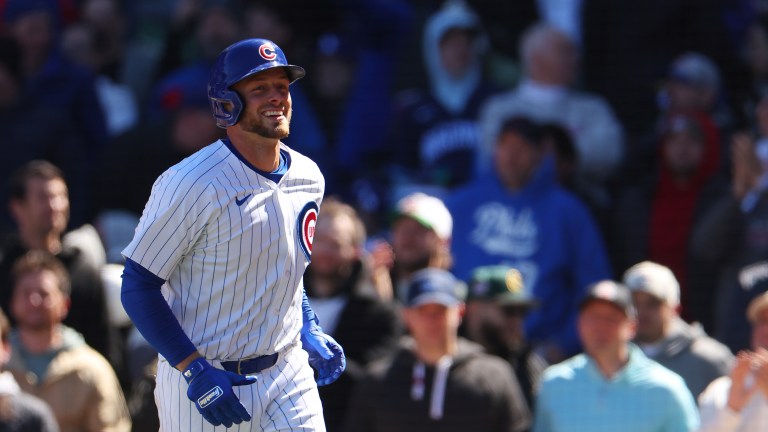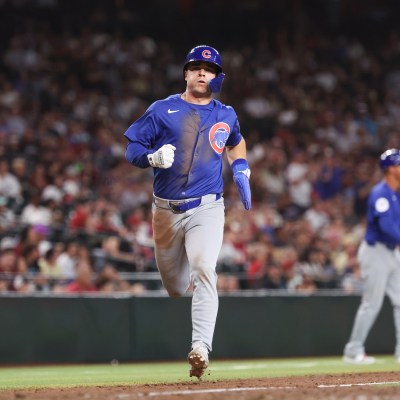Michael Busch Is Becoming One of MLB’s Best First Basemen
Michael Busch is quickly establishing himself as a vital piece of Chicago's offense and one of the best first basemen in the game.

Stats and rankings taken prior to first pitch on April 23.
The Chicago Cubs have one of the most prolific offenses in baseball. They lead MLB in runs per game at 6.24, they have the highest OPS in the sport at .805, and they’ve scored 10 or more runs in a game seven times already this season, which is the most in MLB.
They’ve received contributions from top to bottom in their lineup, and one of the most vital contributors leading the way on offense has been 27-year-old first baseman Michael Busch.
Busch, who was acquired in January of 2024 via trade from the Los Angeles Dodgers, is building upon his successful rookie campaign from a season ago. He’s taken yet another step forward in the early stages of the 2025 season, blossoming not only into one of the Cubs’ most valuable hitters, but one of the best first basemen in the game thus far.
Breaking Down Michael Busch’s Hot Start
While superstar Kyle Tucker has truly led the way for this high-octane Cubs offense, Busch hasn’t been too far behind in many categories.
Among qualified hitters, Busch is second on the team in wRC+ (162), wOBA (.409), OBP (.370), SLG (.578), and ISO (.277). Likewise, his batting average of .301 and fWAR of 0.7 rank third among qualified Cubs hitters.
He’s thriving as the cleanup hitter in a stacked Cubs lineup. What’s more, few first basemen have put together hotter starts than Busch at the plate.
Of course, Pete Alonso has been one of the best hitters in MLB through the first month of the season, pacing the position in fWAR (1.6) and wRC+ (211). However, Bush is right there behind him in many statistical categories.
Among qualified National League first basemen, Busch is second in ISO, slugging percentage, and wRC+. He’s also third in wOBA, batting average, and fWAR. If you expand the scope to all first basemen across MLB, Busch is top six in OPS and top five in wRC+, wOBA, ISO, and batting average.
It’s been a terrific start for the 27-year-old, and his numbers are up there with players who have led the position for years; such as Matt Olson, Bryce Harper, and Alonso. In some cases, he’s been even better than some of those more notable names to open the 2025 campaign.
Of course, it’s still early in the season, as hitters are just starting to eclipse 100 plate appearances on the year. But nonetheless, it’s encouraging to see Busch establish himself as a focal point of Chicago’s offense in just his second full big-league season.
Strong Quality of Contact
Busch’s talent was never in question, as he demonstrated time and time again throughout his time in the minors that he was a very capable hitter. He was hitting for both contact and power at every stop — he just needed the runway to establish himself in the majors.
He finally got that opportunity last season, and Bush put together a strong rookie campaign, flashing the tools that made him such an intriguing trade chip an offseason ago.
In 567 plate appearances in 2024, Busch slashed .248/.335/.440 and hit 21 bombs, put up a 119 wRC+, and ended with a 2.3 fWAR. Among qualified MLB first basemen, Busch was top 10 in OPS, wRC+, wOBA, and fWAR. That’s quite a respectable season, especially for a rookie.
On top of the improved surface-level numbers, Busch has done a great job of replicating what he did well a season ago, as well as improve several aspects of his game.
In terms of quality of contact, Busch has picked up right where he left off from last season. He’s above average in barrel rate (10.0%), average exit velocity (90 mph), and hard-hit rate (40%). Each of those marks are similar to where they were at a season ago.
Those numbers might not fly off the page as elite, but it has led to some quality hitting in the early going of the season, as 12 of his 25 hits so far have been for extra bases.
But racking up extra-base hits is nothing new for Busch. After all, he hit 51 of them in 2024. Instead, it’s been his ability to pair that strong contact and disciplined approach that we saw in 2024 with improved contact numbers.
A Disciplined Approach With Improved Contact Rates
One thing Busch did quite well last season was minimize his chase, and he’s continued with that this season with a chase rate of 23.4%. That’s right in line with where that number was at last season.
On top of his impressive feel for the zone, it’s encouraging to see his swing-and-miss rate improve. He was in the 28th percentile in whiff rate a season ago, and he’s managed to cut that by nearly two percent so far in 2025.
What’s more, it’s been the slight step forward in his in-zone contact rate that’s noteworthy. There’s certainly room for improvement with the number sitting at 81.5%, but that’s nearly a two-percent increase from his mark in 2024.
That may seem like a slight increase, but any improvement in that area of Busch’s game will go a long way, especially considering the damage he can do on pitches in the strike zone.
On an even more granular level, Busch is doing much more damage against spin in the early goings of 2025.
Busch already has three homers off of breaking balls this year. For comparison, he had five all of last season. As a result, it’s no surprise to see his average exit velocity against the pitch type go from 87.8 mph last year to 93.3 mph in 2025.
Against breaking balls, his batting average is up nearly 30 points, his whiff rate is down nearly nine percent, and he’s been producing much higher quality of contact against the pitch type, highlighted by his .773 slugging percentage.
Again, it’s important to remember that we’re working with a fraction of the sample size this early in the season. He’s not going to maintain that slugging number for the entirety of 2025, but for a player who was whiffing over 38% of the time against breaking pitches last season, his stride forward in that department is mighty encouraging.
Moreover, it’s one thing to improve production against breaking pitches, but he’s also been able to maintain his strong production against fastballs in the process.
His numbers on the surface level this season against heaters are similar to where they were at in 2024 with some slight improvements. His batting average is up 20 points, and much of that has to do with his drop in whiff rate against the pitch type.
In 2024, Busch was swinging and missing 21.3% of the time against fastballs. So far this season, he’s dropped that whiff rate to just 14.9%.
Once again, while it may be a smaller sample size, his ability to make more contact and do more damage against both fastballs and breaking balls — which make up nearly 80% of the pitches he’s seeing — is a large reason why he’s been so successful in the early goings of 2025.
Opposing pitchers are having a difficult time finding a way to attack him, and that’s certainly reflected in his strong production at the plate thus far.
Closing Thoughts
In order for Busch to truly establish himself as one of the best first basemen in Major League Baseball, he will obviously have to prove that he’s capable of maintaining this level of production over a full season.
Specifically, he will need to prove that his early-season improvements in the contact department are sustainable.
In Busch’s cup of coffee with the Dodgers back in 2023, Busch struck out 33.3% of the time. In 2024, while punchouts were still a noticeable issue, he cut that rate to 28.6%. So far this season, he’s continued with that positive trend, dropping his strikeout rate over three percent to 25%.
That mark is still below league average, but seeing him develop as a hitter as he gets more exposure to major league arms is rather encouraging.
Being the talented hitter that he is, if Busch can make contact more often with pitches within the strike zone, good things will happen. And we’ve seen that come to fruition so far this season.
The 27-year-old is still coming into his own as a major league hitter. He’s quickly establishing himself as one of the more promising first basemen in baseball, and Busch’s evolution in the box has been key to Chicago’s offensive surge.


